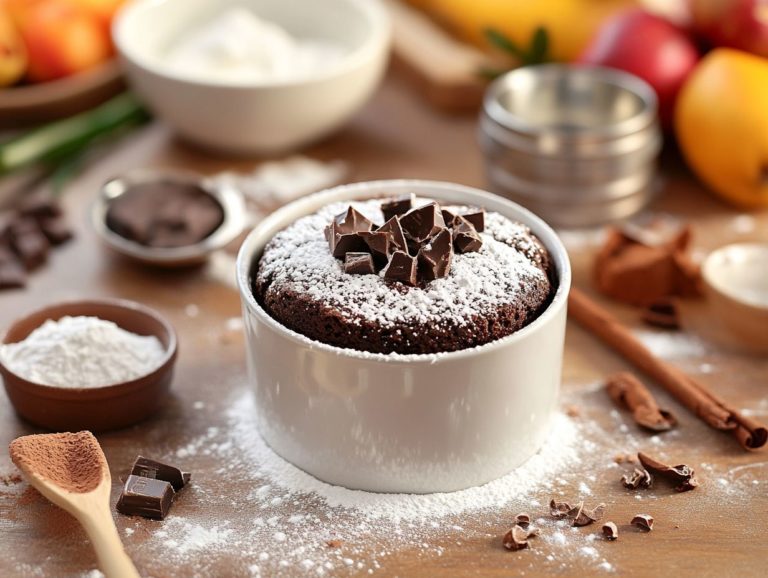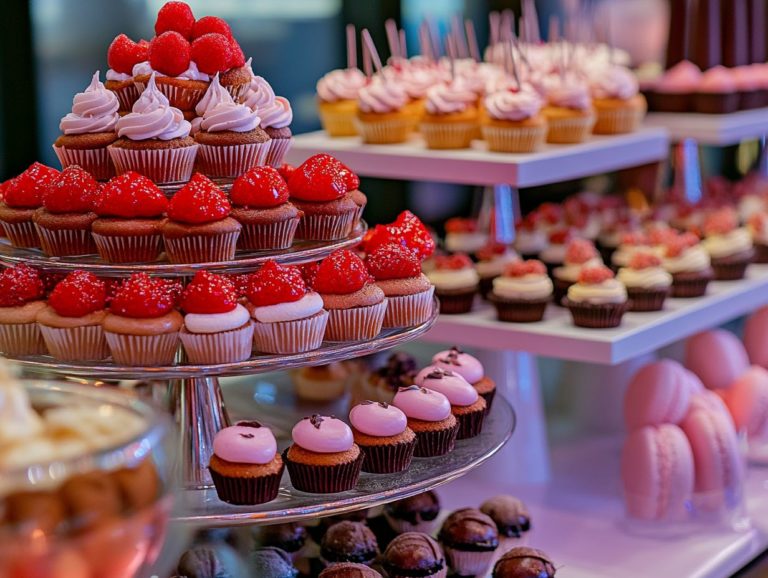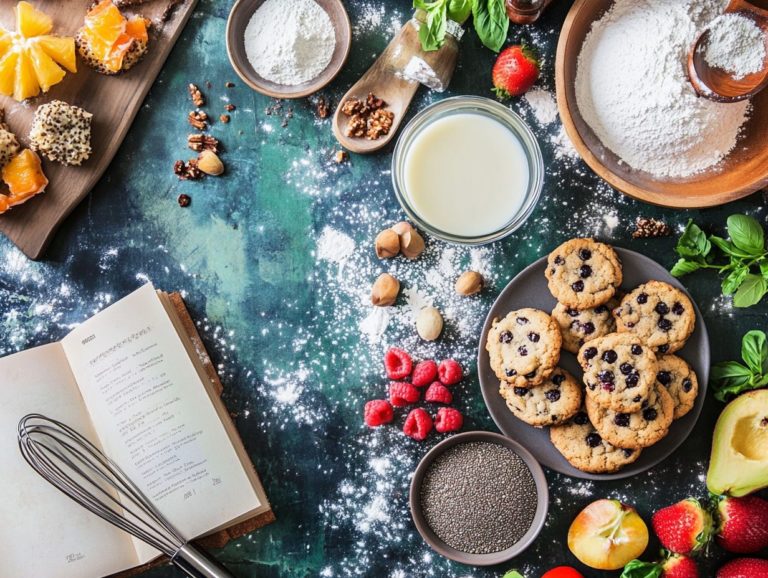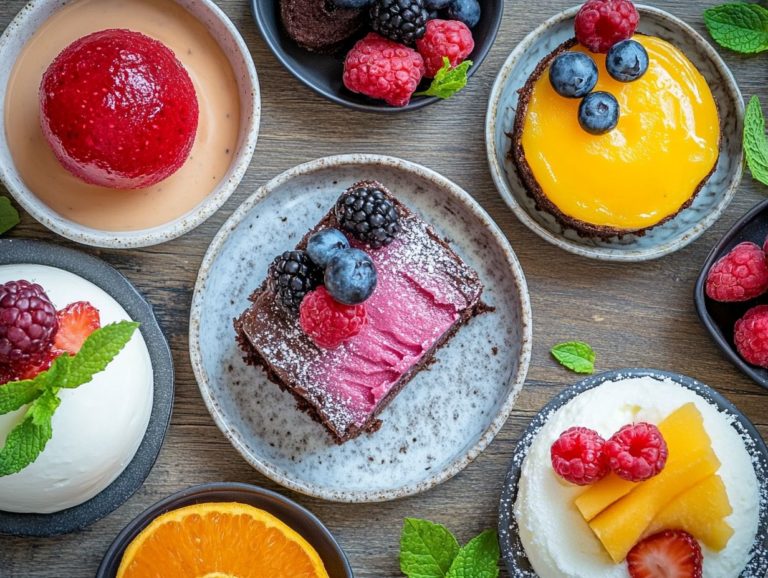How to Make Puddings and Custards?
Puddings and custards are beloved desserts that delight the senses! They bring together a delightful mix of flavors and textures, making them an essential part of any culinary repertoire. Whether you savor a warm, comforting baked pudding or prefer the smoothness of a chilled custard, mastering these homemade recipes can truly elevate your dessert experience.
This guide will delve into the fundamental recipe ingredients, explore the various types of puddings and custards, and provide step-by-step preparation methods. You’ll also discover invaluable cooking tips to ensure your creations are flawless every time.
Get ready to dive into the exciting world of sweet science and create mouthwatering desserts that will impress everyone, like vanilla custard and chocolate custard!
Contents
- Key Takeaways:
- What Are Puddings and Custards?
- What Are the Basic Ingredients for Making Puddings and Custards?
- Essential Ingredients for Puddings and Custards
- Explore Delicious Types of Puddings and Custards!
- What Are Some Tips for Making the Perfect Puddings and Custards?
- Frequently Asked Questions
- What are the basic ingredients needed to make puddings and custards?
- What is the difference between puddings and custards?
- Can I use alternative sweeteners in my pudding or custard?
- How do I prevent my custard from curdling?
- Can I make pudding or custard in advance?
- Can I use non-dairy milk in my puddings or custards?
Key Takeaways:
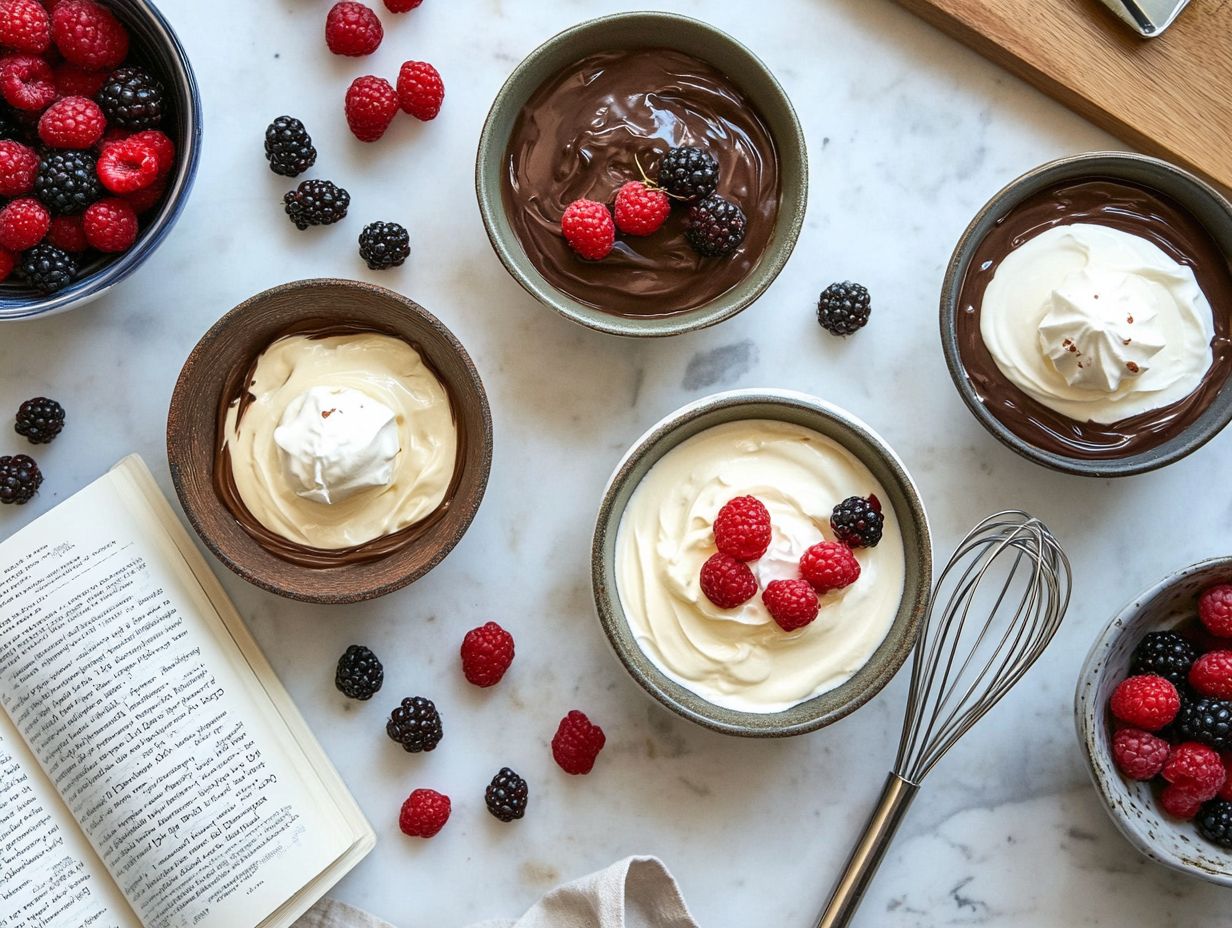
- Use fresh, simple ingredients for the best tasting puddings and custards, such as vanilla extract and egg yolks.
- Follow the recipe carefully to ensure the right ratios and cooking times, paying attention to cooking instructions and preparation steps.
- Use the right cooking equipment, such as a double boiler (a kitchen tool that uses steam to gently cook delicate sauces and desserts) or baking pan, for the desired texture and consistency.
What Are Puddings and Custards?
Puddings and custards are cherished desserts that transport you to warm, nostalgic moments in family kitchens. They are often crafted with simple ingredients and time-honored techniques that have been lovingly passed down through generations, like those from Grandma’s old fashioned recipes.
Traditionally, puddings boast a smooth and creamy texture. Custards think vanilla custard and egg custard delight with their rich flavor profiles, making them versatile stars in a multitude of dessert recipes. Enjoy these creamy flavors in a variety of custard desserts.
Whether you re whipping up classic homemade custard or exploring intriguing variations like chocolate custard and easy tapioca, these sweet indulgences offer unparalleled comfort, captivating dessert lovers around the globe.
What Are the Basic Ingredients for Making Puddings and Custards?
The essential elements for crafting delightful puddings and custards are milk, sugar, eggs, and an array of flavorings, each playing an important role in creating the rich, creamy flavors that characterize these desserts.
Milk forms a luxurious base, while sugar adds the perfect touch of sweetness. Eggs act as a vital thickening agent, delivering that ideal consistency you crave. By incorporating flavorings like vanilla extract or chocolate, you can elevate your custard creations, transforming them into versatile sweet indulgences tailored to your unique tastes.
1. Milk
Milk is an essential ingredient in crafting both puddings and custards, offering a creamy texture and richness that serves as the foundation for numerous recipes. Your choice between whole milk and light cream or heavy cream will significantly influence the overall flavor and consistency of your dessert, allowing you to tailor it to various taste preferences.
The type of milk you select is instrumental in shaping the dessert’s final creamy qualities. Higher fat contents often result in a silkier, more indulgent creation. For example, incorporating heavy cream can elevate the richness to a whole new level, deeply enhancing both the mouthfeel and flavor profile. This will give your homemade custard the perfect vanilla flavor.
On the other hand, if you opt for skim or low-fat milk, you’ll achieve a lighter version of these treats, although you may sacrifice some of that luscious, velvety texture. Consider using a cornstarch thickener for a smooth and creamy finish.
The interaction between milk and the egg mixture is crucial for the custard’s ability to set, emphasizing the delicate balance between ingredients that makes these desserts so cherished. Remember to reference the recipe notes for specific advice on achieving the ideal consistency.
Essential Ingredients for Puddings and Custards
2. Sugar
Sugar is essential in your puddings and custards. It provides a sweetness that elevates the entire flavor profile of your dessert. As it dissolves during cooking, it creates that smooth consistency you crave, transforming the final product into a delightfully sweet treat that captivates your palate.
But sugar does more than just sweeten; it serves as a balancing agent that counteracts any bitterness from ingredients like cocoa or dark chocolate. Experimenting with different types of sugar can introduce a world of diverse tastes and textures. For example, granulated sugar offers a clean sweetness, while brown sugar, with its rich molasses content, adds a deeper, more complex flavor that enriches your dish. Consider adding butter richness to enhance the overall flavor.
The moisture-retention properties of brown sugar also contribute to a creamier texture in custards, enhancing their overall richness. The choice of sugar plays a pivotal role in determining the sweetness and satisfaction of your dessert, making it essential for achieving that perfect balance you desire.
3. Eggs
Eggs, especially egg yolks, serve as a vital thickening agent in your puddings and custards. They add to that rich, creamy texture you crave. As the proteins in eggs coagulate during cooking, they provide the structure and luxurious mouthfeel essential for an authentic homemade custard experience. Be sure to follow the proper custard recipe to achieve the best results.
When incorporating eggs, use gentle techniques like tempering, which is the process of gradually mixing hot liquids into eggs. This method allows you to slowly introduce hot mixtures to your beaten eggs, preventing any unsightly curdling. It ensures a smooth blend while preserving the delicate nature of the yolks. Use a hot water bath (bain-marie) during the baking process to maintain even cooking.
Using fresh, high-quality eggs is crucial. They greatly enhance both flavor and consistency. Fresh eggs improve emulsification, resulting in a velvety texture that elevates your puddings and custards to a level of indulgence that s simply extraordinary.
Eggs are the magic ingredient that brings your puddings and custards to life! These culinary creations depend on their unique properties not only to achieve the ideal consistency but also to develop a rich taste that is utterly irresistible. Always check custard FAQs for troubleshooting tips and serving suggestions.
4. Flavorings
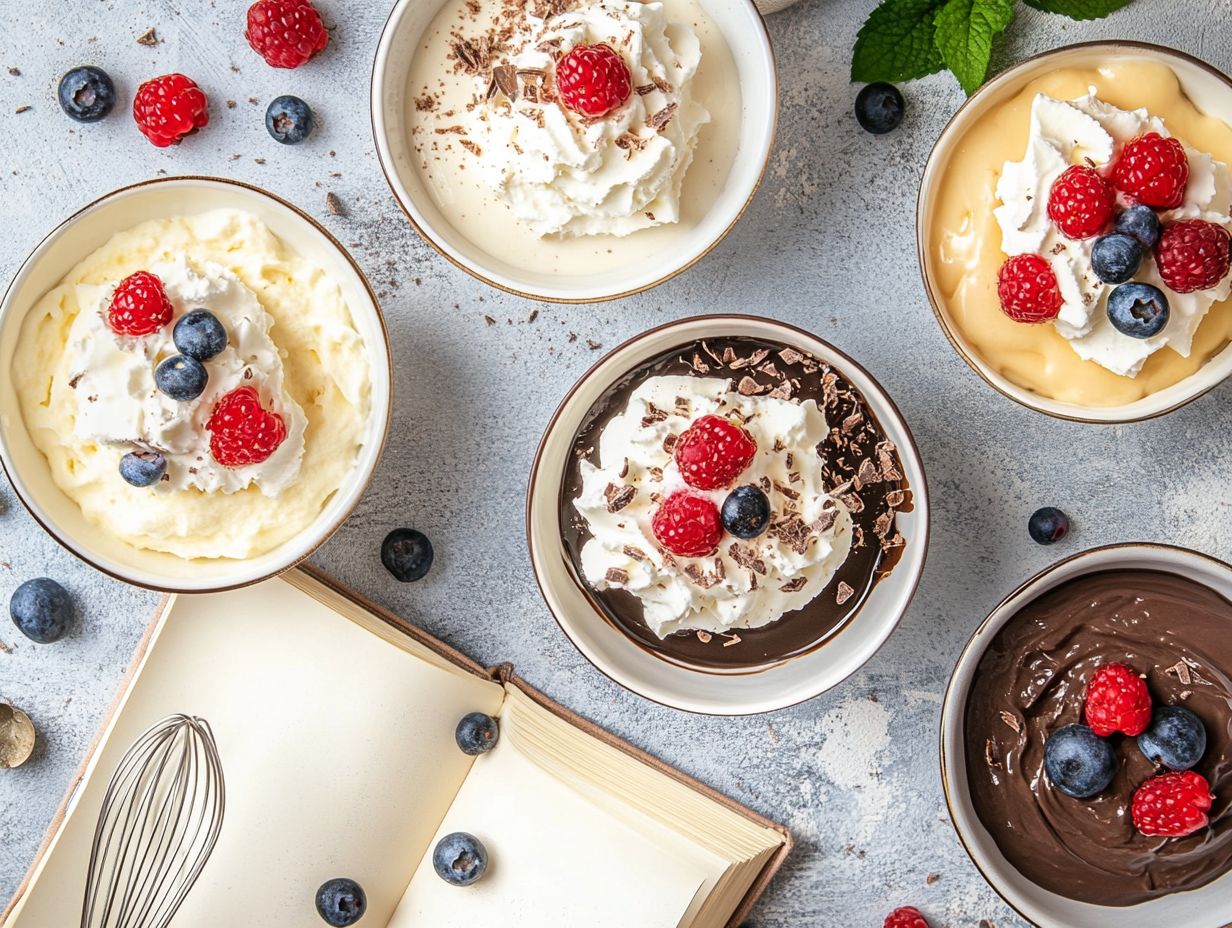
Flavorings, like vanilla extract or cocoa powder, are essential in shaping the taste of your puddings and custards. They offer you endless recipe variations tailored to your personal preferences. These ingredients not only enhance sweetness but also introduce exciting dimensions to your culinary creations, transforming a classic vanilla custard into an indulgent chocolate delight or sparking other creative interpretations. Consider adding a rich caramel swirl for an extra layer of flavor.
As a pudding enthusiast, you’ll likely find yourself exploring a world of flavoring possibilities. Aromatic spices like cinnamon or nutmeg can add a welcoming warmth, while vibrant extracts such as almond or coconut bring their own unique character to your dish. For a tropical twist, incorporate fresh fruits or zest from citrus for a bright and refreshing flavor.
The choice of milk, whether you opt for dairy or plant-based, also significantly influences the overall flavor profile. Incorporating fresh fruits or zest from citrus can brighten up a traditional custard. A rich caramel swirl can elevate even the simplest puddings into a gourmet experience. Use custard cups for individual servings and top with homemade whipped cream for an extra touch of luxury.
Ultimately, these choices give you the power to infuse your creations with distinct flavors that celebrate your individual tastes. Get creative in the kitchen and try these flavor combinations today!
Explore Delicious Types of Puddings and Custards!
You ll discover a delightful array of puddings and custards that cater to a variety of flavors and textures, including baked puddings, steamed puddings, chilled puddings, and instant puddings. Each type brings its own unique qualities and experiences to the table.
For instance, baked puddings envelop you in a cozy warmth, whereas chilled puddings provide a refreshing twist that s perfect for warmer days. Then there’s the custard pie a timeless favorite that beautifully showcases the versatility of these creamy desserts across various culinary traditions.
1. Baked Puddings
Baked puddings, with their warm and comforting embrace, are a timeless dessert choice for those who appreciate the luxurious combination of egg custard and a slightly firmer texture. As the baking process unfolds, the flavors meld harmoniously, resulting in custard desserts that are nothing short of satisfying indulgence. Remember to monitor the baking time to achieve the perfect consistency.
These creations usually include essential ingredients such as eggs, milk, cream, sugar, and flavorings like vanilla or nutmeg, creating a blend of flavors that dances on your palate. Baked puddings offer a variety of classic recipes from the beloved bread pudding, which elegantly features cubes of stale bread for added texture, to the hearty rice pudding, renowned for its creamy consistency thanks to cooked rice. Consider serving with leftover custard for added richness.
You might even encounter variations that introduce ingredients like rich chocolate or vibrant fruits, elevating both the flavor and visual appeal to new heights. Baking in a gentle water bath creates a flawless texture, ensuring that everything cooks evenly without the risk of curdling, enhancing the delightful experience with each delectable bite. Try baking with custard cups for individual portions and a perfect finish.
2. Steamed Puddings
Steamed puddings are well-known for their moist, tender consistency, making them a beloved element of traditional dessert recipes. This cooking method preserves the delicate flavors, resulting in desserts that provide both comfort and richness, often enhanced by spices and fruits that elevate the overall experience. Follow the cooking process closely for the best results your taste buds will thank you!
These treats boast a rich historical significance, tracing their roots through various cultures, from the classic British Christmas pudding to the enticing Asian mango sticky rice. Each recipe reflects unique regional ingredients and culinary traditions, demonstrating how steamed puddings can be tailored to suit diverse palates, incorporating flavors such as luscious chocolate, zesty citrus, or warm spices like nutmeg and cinnamon. Consider reading custard FAQs for more insights into these traditional delights.
The gentle steaming process not only ensures the puddings remain soft but also allows the ingredients to meld together beautifully, making every bite unforgettable. This old-fashioned method is a testament to the rich culinary traditions passed down through family kitchens. Often prepared during celebrations and gatherings, steamed puddings carry with them not only rich flavors but also a deep sense of nostalgia and community.
3. Chilled Puddings
Chilled puddings are a delicious dessert that is great for warm weather. They provide a light and creamy treat that combines sweetness and flavor.
These simple ingredients come together to create a delicious dessert that is sure to please. You can savor these desserts in various forms, from vibrant fruit-infused creations to timeless classics like cold vanilla custard or egg custard, catering to those who desire a delightful finish to their meal.
A standout choice is the zesty lemon pudding, which delivers a refreshing tang. Chocolate mousse tempts you with its rich, velvety texture. If a fruity option is what you seek, consider the ease of preparing mango or coconut puddings, or even a tapioca pudding that incorporates fresh ingredients to elevate the entire experience.
Serving these luscious puddings in elegant ramekins or glasses enhances their presentation and makes portion control easy. When adorned with whipped cream, fresh berries, or a sprinkle of toasted nuts, these chilled delights satisfy any discerning palate. They are especially cherished during the warmer months as a refreshing treat.
Don’t miss the chance to add a dollop of homemade whipped cream for a touch of luxury!
4. Instant Puddings
Instant puddings offer a wonderfully convenient solution for your dessert preparation. They allow you to indulge in a sweet treat without the need for extensive cooking.
With quick recipes that require minimal ingredients, these puddings are ideal for satisfying your cravings in a hurry. They come in a delightful array of flavors to cater to your diverse tastes.
Instant puddings turn a simple kitchen moment into a delightful treat with ease. If you’re navigating a busy schedule, these desserts provide an accessible way to whip up a memorable treat for family gatherings or casual get-togethers.
In just a few minutes of mixing and chilling, you can create a creamy delight that rivals even the most traditional recipes, such as homemade custard or chocolate custard. The possibilities for customizing flavors from classic vanilla and rich chocolate to adventurous options like salted caramel or banana cream make instant puddings versatile and a canvas for your creativity.
Adding a touch of vanilla extract can also enhance the overall flavoring possibilities. A sprinkle of your favorite toppings or a swirl of fresh fruit can elevate your dessert, making it both visually appealing and practical in today s fast-paced dessert culture.
What Are the Steps for Making Puddings and Custards?
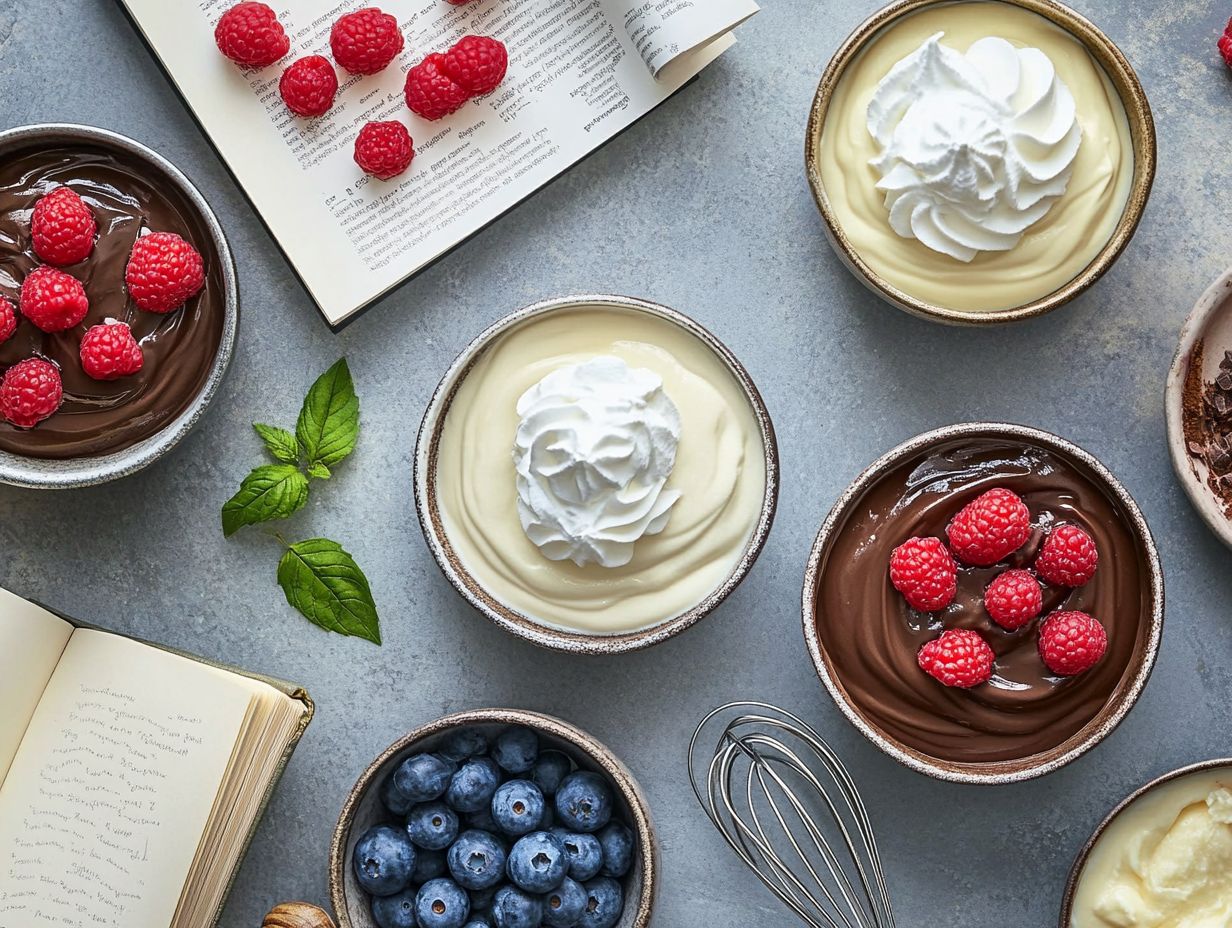
The process of creating puddings and custards is elegantly simple and leads to rich, indulgent desserts. It demands your careful attention and respect for the recipe.
Begin with fundamental preparation steps: measure your ingredients with precision, combine them thoughtfully, and keep a watchful eye on cooking times. These initial preparation steps are crucial for achieving the perfect consistency and flavor for your delightful creations.
Are you ready to embark on a delightful journey to create perfect puddings and custards? Follow these steps to ensure a successful cooking experience that will impress your guests.
1. Preparing the Ingredients
Preparing the ingredients is a crucial first step in your quest to craft perfect puddings and custards. Ensuring each component is measured accurately and of high quality will set you up for success. Paying attention to your recipe ingredients can make all the difference.
This attention to detail lays the groundwork for a remarkable cooking process and an irresistible final product. Using simple ingredients like egg yolks, sugar, and milk can result in a dessert that is both classic and delightful.
The art of ingredient preparation goes beyond the basics; it s about selecting the freshest eggs, dairy, and flavorings that will elevate your dish to new heights. When measuring, opt for weight over volume for greater precision. This simple choice can save you from mishaps like overly thick or runny textures, ensuring that your custard treats come out perfect every time.
Stay mindful of common pitfalls, such as using stale ingredients or skimming over the recipe, as these can lead to inconsistent outcomes. Refer to your recipe notes to avoid any mistakes.
By committing to meticulous preparation, you transform cooking into an enjoyable and rewarding experience, leading to exquisite puddings and custards that will undoubtedly impress everyone at your table.
2. Mixing the Ingredients
Mixing the ingredients requires your careful attention as you combine the milk, sugar, eggs, and any flavorings to create a smooth and homogeneous batter. Ensuring the sugar dissolves completely is essential for achieving a smooth end result. This step is vital for creating a creamy texture in your puddings and custards.
To attain that luscious consistency, whisk vigorously and continuously. This not only incorporates air but also prevents pesky lumps from forming. Start by whisking the eggs and sugar together until they become pale and thick, then gradually add the warm milk to temper the eggs this keeps them from scrambling. This step is particularly important when preparing a custard pie or other baked custard.
To ensure a silky texture, consider using a fine mesh sieve to strain out any lumps before cooking. This is especially useful when making ice cream or any custard treats.
For an even creamier finish, you might use a hand mixer for a brief moment, but be cautious not to overbeat the mixture; excess air or curdling is the last thing you want. The use of a double boiler can help maintain a more controlled temperature. With these simple techniques, you’ll soon create decadent puddings and custards that are delightfully smooth and bursting with flavor. Don’t forget to consider your serving suggestions for an impressive presentation.
3. Cooking the Pudding or Custard
Cooking the pudding or custard is a crucial step that demands your careful attention to ensure the mixture thickens perfectly without curdling. Utilizing a thickening agent like cornstarch thickener can help achieve the desired consistency. Techniques like a double boiler or a baking pan filled with hot water allow you to maintain a steady, gentle heat.
By following precise cooking instructions, you can achieve a beautifully set dessert that boasts a smooth and creamy consistency. Refer to your custard FAQs for any troubleshooting tips.
Temperature control is absolutely vital in this process. Using tools like the ThermaPen from Thermoworks can help maintain accuracy. Too high a heat can transform your silky creation into a scrambled mess, which is not what you want. It s essential for you to stir continuously and keep a close eye on the cooking time to reach the desired thickness without the risk of overcooking.
Many recipes even suggest cooking until the mixture coats the back of a spoon this is the hallmark of that perfect custard-like texture, much like in a traditional Spanish Flan or Creme Brulee.
Whether you choose the stovetop method or opt for a baked custard in the oven, understanding how heat interacts with your ingredients will undoubtedly elevate this classic dish into a delightful treat. Using a baking pan filled with hot water can also help maintain a consistent temperature.
Now that you know the steps, get ready to impress your guests with your delicious creations!
What Are Some Tips for Making the Perfect Puddings and Custards?
To create the perfect puddings and custards, you must embrace a few essential tips that elevate the entire process, guaranteeing consistent results and exquisite flavors.
By prioritizing quality ingredients, maintaining accurate amounts, and using effective cooking techniques, your homemade recipes can achieve the desired creamy texture and rich taste that truly define these beloved desserts.
1. Use Fresh Ingredients
Importance of Freshness
Using fresh ingredients is essential for crafting exceptional puddings and custards. The quality of elements like egg yolks and vanilla extract profoundly influences the flavor and texture of your final dessert. Fresh ingredients ensure that every bite is brimming with authentic taste and creamy delight.
For instance, using light cream can add a lovely richness to your desserts. To achieve the best results, focus on the sourcing and selection of these key components.
Choosing Quality Products
When choosing egg yolks, look for vibrant color as a sign of freshness. For vanilla, opting for whole beans or high-quality extracts can elevate the depth of flavor remarkably. This is crucial for achieving that perfect vanilla flavor in your desserts. Considering the origin of your dairy products, like cream and milk, can transform a good dessert into an unforgettable one.
The butter richness also plays a significant role in the overall taste. When you embrace seasonal fruits, you’re not just adding a burst of freshness; you’re infusing the dish with natural sweetness that elevates the overall dessert experience, creating a delightful treat for your palate. These delightful sweets will wow your guests!
2. Follow the Recipe Carefully
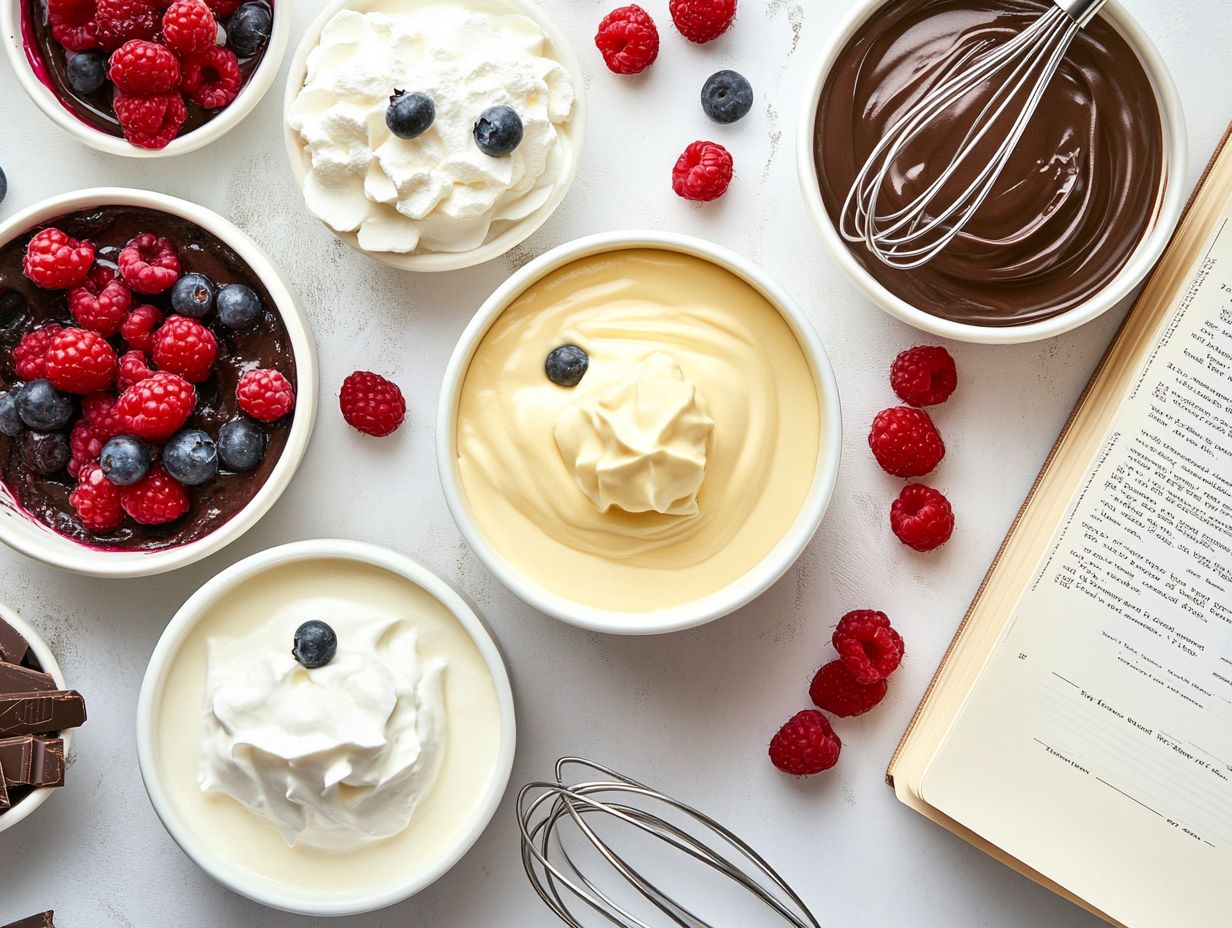
Carefully following the recipe is crucial for achieving delicious desserts. Precise measurements and strict adherence to the cooking process play a significant role in the final outcome. The correct baking time is also critical for achieving the perfect texture. This approach ensures consistency and guides you toward that desired creamy texture and rich flavor.
The ingredient ratios are crucial for creating the ideal balance. Specific ratios of ingredients like eggs, sugar, and milk are essential. When making a custard recipe, following these ratios is crucial for success. For example, if you decide to swap whole milk for a low-fat version, you may find the richness diminished, resulting in a less indulgent final product.
Always ensure that the egg mixture is well-incorporated for the best results. Moreover, variations in cooking times and temperatures can lead to inconsistencies in texture from a lumpy custard to a pudding that s far too thick. Don’t rush! Taking your time ensures every dessert is a masterpiece!
By sticking closely to the outlined steps, you not only pay homage to those tried-and-true recipes but also significantly enhance your chances of crafting delightful desserts that will surely impress your family and friends. Don’t forget to consult any cooking tips that might help you along the way.
Get Started on Your Dessert Adventure!
Now that you have these tips, it’s time to roll up your sleeves and start making your own puddings and custards. With quality ingredients, careful measurements, and a little patience, you can create desserts that are not only delicious but also truly memorable!
3. Use the Right Cooking Equipment
Using the right cooking equipment is essential for achieving perfect puddings and custards. Tools like a double boiler or a baking pan filled with hot water create the ideal environment for gently cooking your mixture to perfection. The right equipment helps you maintain optimal temperatures, preventing curdling and ensuring a smooth, creamy result. Whether you’re making homemade custard, egg custard, or an old fashioned custard recipe, using proper tools can make a significant difference.
Plus, these must-have tools, along with a reliable whisk and a set of measuring cups, can significantly enhance your preparation process. A whisk not only helps you achieve the desired aeration but also ensures that your ingredients blend seamlessly. Measuring cups provide the accuracy necessary for precise ratios, which is crucial in recipes that depend on specific ingredient interactions. Additionally, using a fine mesh strainer for your egg mixture can help ensure that the sugar dissolves thoroughly, offering a smooth and creamy finish.
Utilizing a fine mesh strainer can help you remove any potential lumps, guaranteeing that your final product is silky and inviting. By investing in these essential tools, you can elevate the quality of your puddings and custards, resulting in desserts that are both delightful to the palate and visually appealing. Whether you’re preparing a delicious dessert like Creme Brulee, Spanish Flan, or tapioca pudding, having the right gear makes a difference.
Frequently Asked Questions
Custard FAQs
What are the basic ingredients needed to make puddings and custards?
The basic ingredients for making puddings and custards are milk, sugar, eggs, and a thickening agent such as cornstarch or flour. These simple ingredients are commonly found in family kitchens and serve as the foundation for nearly any dessert recipe.
What is the difference between puddings and custards?
Puddings are typically made with milk, eggs, and a thickening agent, while custards are made with milk, eggs, and sugar. Custards are also cooked on the stovetop or in the oven, while puddings can be cooked on the stovetop or chilled in the refrigerator. For instance, an easy tapioca pudding can be an excellent example of a pudding, while a creamy vanilla egg custard demonstrates the difference in flavoring possibilities.
Can I use alternative sweeteners in my pudding or custard?
Recipe Variations
Yes, you can use alternative sweeteners such as honey, maple syrup, or even artificial sweeteners. Just be sure to adjust the amounts accordingly to achieve the desired level of sweetness. Consider incorporating vanilla extract or light cream to enhance creamy flavors and achieve a richer taste.
How do I prevent my custard from curdling?
Cooking Tips
To prevent your custard from curdling, make sure to cook it over low heat and constantly stir it. Avoid bringing it to a boil and remove it from the heat as soon as it thickens. Additionally, using a ThermaPen from Thermoworks can help monitor the optimal temperatures to avoid curdling.
Can I make pudding or custard in advance?
Preparation Steps
Yes, puddings and custards can be made in advance and stored in the refrigerator for a few days. Just be sure to cover them with plastic wrap or place them in an airtight container to prevent a skin from forming on top. For example, making a tapioca pudding or a chocolate custard ahead of time can save you preparation steps during busy occasions.
Can I use non-dairy milk in my puddings or custards?
Recipe Variations
Yes, you can use non-dairy milk such as almond milk, coconut milk, or soy milk in your puddings and custards. Just make sure to use full-fat versions to ensure a creamy texture. This can be particularly useful in recipe variations when catering to dietary restrictions while still aiming for a smooth and creamy texture.

